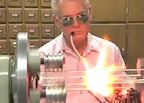A postcard-size sign hangs from the ceiling of the second floor of Pierce Hall on the University of California, Riverside campus. It says: “GLASS SHOP.”
The shop is the domain of Stan Sheldon, the university’s scientific glass blower. Scientific is the key word. Sheldon makes custom glass pieces for chemists, engineers and other researchers on campus. He doesn’t do vases or swans.
Sheldon, a 1969 graduate of UC Riverside who has worked at the university on and off for nearly 30 years, works in the glass shop on Wednesdays. That is quite a decline from decades ago when there were two glass shops with three full-time glassblowers on campus.
The decline mirrors what has happened nationwide. Scientific glass blowing peaked in the 1960s when the Cold War caused the government to ramp up spending on scientific research, said Robert Ponton, who runs the American Scientific Glassblowers Society. He said membership in the society is down about 20 percent from the peak.
Today, as research has shifted from the bench to the computer and from a macro- to a micro-scale there is less of a need for custom-made glass pieces, said Ponton, who spent 30 years as a scientific glass blower.
At UC Riverside, Sheldon got his start glassblowing in 1973. He did an 18-month apprenticeship under Josef Poppl in the same Pierce Hall shop he works in today.
In the following 30 years, he used his glassblowing skills periodically when working at labs at UC Riverside, UC Irvine, Brigham Young University and Imperial Valley College.
Then, in 2006, Volker Herbert, who was a full-time glassblower at UC Riverside, retired. Sheldon, who was and continues to work in the chemistry lab of at the university, heard about Herbert’s retirement and offered his services. The university hired him, but only for one day per week because of the declining demand for glassblowing and budget considerations.
Pretty much every Wednesday Sheldon has lunch with Herbert, who is fond of saying: “When a professor had a bad dream at night I always said I had an interesting job the next day.”
Today, the glass shop looks much like it did when Sheldon apprenticed 40 years ago. It’s filled with industrial-looking equipment used to heat, cut, drill and cool the custom-made glass pieces. Glass tubes of various diameters are stacked in mailbox-like slots. A stack of completed hand-written work orders form a nearly foot-high pile of pink paper.
Sheldon, who is 67, says he will think about retiring when he hits 70.
“I get real satisfaction helping these young scientists,” he said.
